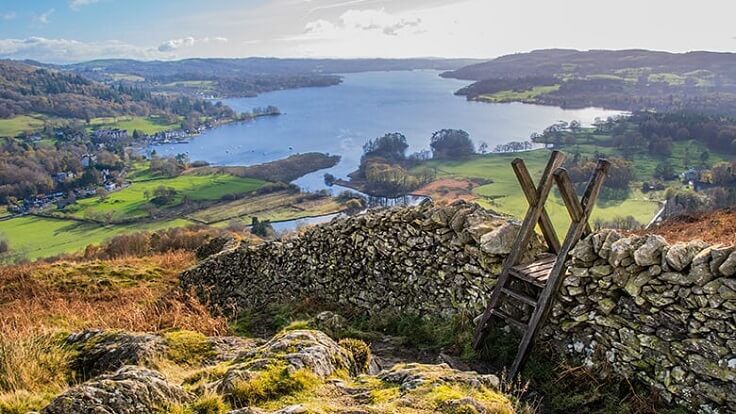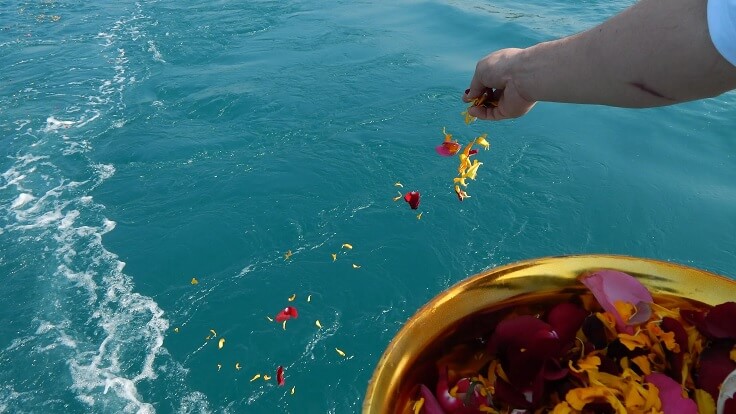Ideas for scattering ashes: the most beautiful locations, ceremony advice and UK laws
Last updated 10th December 2024
5 min read
Scattering ashes is a way for families to celebrate the life of their loved one or honour their last wishes.
In the UK, it's legal to scatter ashes on land and in water, leaving you with lots of beautiful areas to choose from. But often we get stuck on scattering ashes ideas and locations.
Our recent study on funeral costs reveals that only around 1% of people know their loved ones' funeral wishes. For some, this includes where they would like their ashes to be spread.
You may be honouring someone's wishes or choosing the location by yourself. Either way, there are some important things to consider.
Here's our list of the most picturesque, peaceful and accessible areas to scatter your loved one's ashes.

The most picturesque locations
Is your loved one's wish to rest amongst breath-taking scenery? If so, these places show the true beauty of the British landscape – from the Cairns of Scotland to the white cliffs of the southern coast.
- Windermere, Cumbria
- Dartmoor National Park, Devon
- Pembrokeshire Coast National Park
- Yorkshire Dales, Yorkshire
- Loch Lomond, Southern Scotland
- Loch Ness, Scottish Highlands
- Snowdon, Snowdonia National Park
- Whitstable, Kent
- Keswick, Lake District
- Brecon Beacons National Park
- Seven Sisters, East Sussex
- Sandbanks, Dorset
- Durdle Door, Dorset
- Cromer, Norfolk
- Woolacombe, North Devon
- Scarborough, Yorkshire
- Ullswater, Lake District
- Aldeburgh, Suffolk
- Hunstanton, Norfolk
- Fairy Pools, Isle of Skye
The most peaceful locations
It can be difficult to find a spot where you're guaranteed to get some privacy. Here, we've ranked locations based on the number of visitors annually. These are the most peaceful places to say your last goodbyes.
- Carsington Water, Derbyshire
- Stanwick, Northamptonshire
- Rutland Water, Rutland
- St Bees, Cumbria
- Lake Vyrnwy, Powys
- Luskentyre, Outer Hebrides
- Seven Sisters, Sussex
- Dartmoor, Devon
- Wimbleball, Somerset
- Southwold, East Suffolk
- Llyn Idwal, Snowdonia
- Whitstable, Kent
- Loch Shiel, Highlands of Scotland
- Loch Lomond, Southern Scotland
- West Wittering, Chichester
- Exmoor, West Somerset
- Cairngorms, Highlands of Scotland
- Yorkshire Dales, Yorkshire
- Snowdonia, North-western Wales
- Sandbanks, Dorset
The most accessible locations
Some of the most beautiful and peaceful locations are often the most remote. Here, we’ve considered the number of car parks in each place and ranked them by accessibility. It may be worth doing more research into your chosen location to make sure it suits everyone's needs.
- Peak District
- Pembrokeshire
- Loch Lomond
- Brecon Beacons
- Northumberland
- Exmoor
- Whitstable
- Hunstanton
- Southwold
- Scarborough
- Ventnor
- Windermere
- Rutland Water
- Stanwick
- Carsington Water
- Polzeath
- Cromer
- Llanddwyn
- Pennine Way
- Keswick

Scattering ashes: laws and regulations in the UK
There is nothing explicit in legislation to prevent people from scattering ashes. But in most cases, you do need the landowner's permission.
Often people choose to scatter ashes in a place with a personal meaning to the person who's passed. Here are some examples:
- At a natural burial ground
- Over the sea, a river or a body of water
- Private land e.g. a garden, sports ground, private farmland
- National parks
- Mountain summits
- Cliff edges
Permission to scatter ashes
If visiting private land, you need to get permission from the landowner beforehand. Searching the HM Land Registry(www.gov.uk opens in a new tab) can help to find out who owns the land you wish to visit.
Most landowners are happy for people to scatter ashes on their property. But you must be mindful of local ecosystems.

Can you scatter ashes on a beach?
If you choose to scatter on a river or over the open sea, you don't need permission. But you should look at guidance offered by the Environment agency(www.scattering-ashes.co.uk PDF downloads). When scattering ashes on beaches, you may wish to contact local authorities to make sure it's OK.
Other things to consider
Along with securing permissions from landowners, there are some extra factors worth considering.
Weather conditions
The unpredictability of Britain's weather can make planning difficult. So it's important to factor in the forecast when choosing your location. If you're scattering ashes in bad weather, it can be quite upsetting as you can't predict where the ashes may blow.
Accessibility
Often the most picturesque and peaceful locations are inaccessible to many. Uneven terrain and a lack of parking or disability access can exclude a lot of people from attending. It's important to look at these details before you make a decision.
How populated is the area?
A sunny afternoon on Brighton beach sounds like the perfect resting place. But it's unlikely you'll get the peaceful, private send-off you hoped for. Consider how popular an area is. Are there some more private spots nearby to visit? Or can you arrive earlier to avoid the crowds?
Revisiting the location
It could also be worth considering if loved ones will want to revisit the place where you scatter the ashes. Is it close enough for everyone to visit? This may also be important if any surviving partners or relatives want to have their ashes scattered in the same place.
Scattering ashes ceremonies
Unsure of what to do once you arrive at your chosen location? Here are some things you may want to consider when scattering your loved one's ashes:
Say a few words
If you're scattering ashes with your loved ones and friends, you may want to say a few words. There's no right or wrong way to do this. But if you're struggling for inspiration, we recommend sharing some fond memories. Give a thoughtful background on the person and their life, and perhaps recite a poem or meaningful song lyrics.
Take some photos
When you scatter someone's ashes, it's usually all over quite quickly. It's worth having a pause, taking in the scenery around you and capturing the moment where all of your loved ones and friends are gathered together.
Stand upwind
Check which way the wind is blowing to make sure the wind carries the ashes away from you and your loved ones.
Hold the ashes at waist height
Scatter the ashes bit by bit, and at waist height. This way, you can be sure they won't blow towards your face if the wind changes direction.
Save some of the ashes
You don't have to scatter all the ashes at once. You could choose to scatter them in various locations or keep a small amount in an urn at home.
Remember, when you're choosing your special location, always seek permission to scatter ashes first. And it's worth looking up guidance beforehand.
Methodology
In 2021, we analysed over 50 locations across the UK to find the most suitable locations to scatter ashes. This included National Parks, beaches and lakes. We also looked at Instagram data, ONS data, rainfall averages, plus laws and policies to develop and refine our list.
The thoughts and opinions expressed in the page are those of the authors, intended to be informative, and do not necessarily reflect the official policy or position of SunLife. See our Terms of Use for more info.
